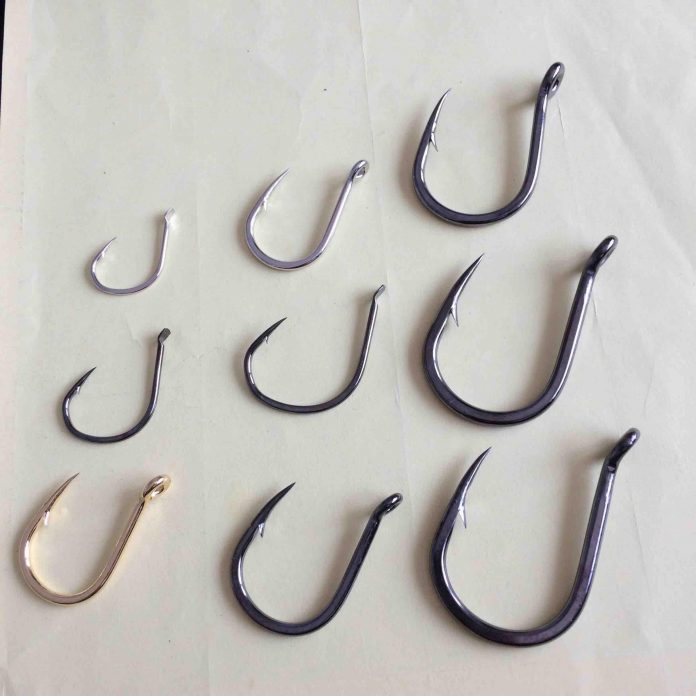Capmel.com on “Hooks”
Once there were times when people caught fish all around me, yet I went fishless. I thought it was bad luck till I learnt to sharpen my hooks. Yes, you can make your own luck.
In those early days I generally used a Limerick pattern, mostly short shank, not that different to what other people were using. I still bought half a dozen hooks with a turned down eye, or maybe some with a turned up eye. Problem was I’d use one and the rest would quietly rust away. Not because they weren’t any good, simply because they were no better.
Is there a formula for selecting the correct hook? No, because there is so much involved. If you made a list of all that’s involved it would start with hook size relative to fish mouth size. Next would be hard, or soft mouth. Then you get into bait size and whether it is alive or dead bait.
Also what about finish? Is silver better than bronze?
As you can see this subject can go on and on, so coming up with a formula is hopeless.
But is there a simple guide for the casual angler, you ask? I’ll go out on a limb and say yes, go to your local tackle shop for a Kendal Kirby pattern hook in two sizes. The smallest is for the fish you will definitely find, the larger size for the fish you HOPE to find.
But for serious fishermen and women the best method is to familiarise yourself with the various parts of a hook, as shown in the accompanying diagram. Then you can take a more involved interest in hooks.
Eye
Eyes are important when ganging hooks, turned down eyes being the most
suitable, with straight eyes sometimes used. The easiest method to use when
ganging is to force the point of one hook through the eye of another. If you
find your hooks have smaller than normal eyes, they will need to be opened a
little with side-cutters, then closed using a solid pair of pliers.
In some cases it is possible to flatten the barb before carrying out the ganging operation to avoid having to open up eyes. Beware when you try to flatten barbs that they may break off. Indeed with stainless steel hooks they definitely will break.
Now comes the real question, which is the type of eye you need for your own fishing: turned up, turned down, straight, large or small. No doubt theories abound but consider only the practical which is, if you need a turned down eye, then buy a turned down eye. The only reason I have ever found to be fussy is when tying on flies or hairy type lures which are bound to the hook. These are easier with a turned down eye. As for actual performance, there seems to be little to recommend one over the other.
Shank
Shanks come long or short. Anything in between is either almost long, or close
to short. Long shanks are useful for bait which is threaded onto hooks such as
prawns and some types of worms. Long shanks are also easier to remove from the
fish, providing you catch fish courteous enough to leave part of the shank
protruding.
To use hooks with long shanks in place of trace wire is not recommended, fish with teeth need wire. To date there is no substitute for a short shank hook and wire.
Short shank hooks are normally used for most other types of bait fishing. They are more easily hidden in the bait and they also take up less space in tackle boxes.
Bend
You can buy hooks with bends set at all angles to the shank (twist). The twist
is said to force the hook to penetrate. The design will work if, again, you
find a fish courteous enough to bite your hook in the correct manner. Unless
the point is angled towards whichever part of the fish it happens to be near,
it will be less effective than straight shank hooks. In fact offset, or twisted
bend hooks will often make the bait spin in a current.
Gape/Throat/Bite
These three features dictates hook size. Gape must be wide so the hook will
penetrate easily and quickly. Throat needs to be deep and the bite should be
long so your bait doesn’t fill the throat completely. If this happens there
will be nothing left free to penetrate the fish. The overall aim is not to have
such a wide gape the fish can’t fit the hook in its mouth.
Barb
These days barbs seem to have grown smaller and less pronounced. Any difference
in holding power is said to be minute. I can’t vouch for this, though it stands
to reason. The big plus is there is now reduced resistance to penetration. A
smaller barb coupled to computer designed shape offers quicker, deeper
penetration with less effort.
Point
If your points are sharp you’re at peace with the world. The real advance in
fish hook manufacture is super sharp hooks straight out of the box. Points need
not be long and thin as was previously the case. They can now be short, smooth
and sharp to get the barb in and holding quickly. This is the essence of
catching fish, to get securely hooked as quickly as possible, with as little
effort as possible.
Size
I believe something called the Redditch Hook Gauge is the standard by which
hook size may be judged. I’m not familiar with this gauge but what I do know
about hook size is this: No 14 is a very small hook, about half the diameter of
a five cent coin. From No 14 down to No 1 hooks grow larger. No 1 is slightly
longer than the diameter of a fifty cent coin. A No 1/0 is one size larger than
a No 1. A No 2/0 is one size larger than a No 1/0 and so on up to 12/0 which is
big enough to catch you a monster (close to 100 mm long including eye).
The other relevant thing with hook size is thickness. A thin hook will penetrate more easily than a thick hook (all else being equal). This is worth remembering if you’re having trouble hooking up on certain species.
Line size is also a factor when selecting hooks. Light line with lots of stretch may not survive the force needed to set a thick hook.
Hooks with a Difference
You will find certain hooks which serve a specific purpose. These will have a
bent shank designed to hold soft plastic lures, or lead head jigs. The other
two common but slightly different hooks are the baitholder and True Turn brand.
Also there is the Eagle Claw’s automatic rotating type. The baitholder is
simply a long shanked hook with a couple of small barbs sliced into the shank.
The name explains the purpose, which is to prevent bait sliding down the hook.
The automatic rotating type are relatively new. These hooks are designed to rotate when held in the fish’s mouth as pressure is applied to set the hook. They aren’t automatic or fool proof, but they do work well.
A quick look through the catalogues will show the massive range of hooks sold worldwide. Buying as I do, from a reputable tackle shop I have had very few bad hooks over the years.
Having said all that, there is little doubt some shoddy hook manufacturers do exist. Buying on price alone is probably the best way to find them.
- Jay Mastry - March 26, 2024
- Captains Corner, Gorta - March 23, 2024
- Dave Zalewski - March 12, 2024











